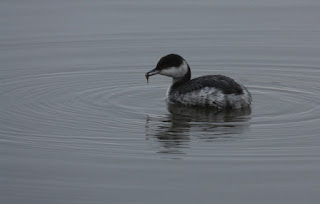31st. As I
waved goodbye to 2015 little did I imagine that within hours I’d be sharing my
time with a redhead Smew (patch
tick) on New Years Day. Even less did I
imagine that I would be watching it still on patch on the last day of
January? Having deserted us for a few
days it returned and clearly knows where it is well off as far as feeding goes
and it’s certainly been an attraction for the bird watching fraternity and
photographers. There must be lots of
images out there now, but I make no apology for adding a few more. The Smew
has been my top bird for the month, and it has been an excellent month with
some great local birding.
Smew
The light was fading as Sam and I checked the lake out
today. The Smew showed extremely well
although the light at times was not all that it could have been, and at times
swam with fellow saw-bills, the Goosanders. It was also good to see the return of a male Gadwall (you may remember a patch tick
for me in December), and we are hoping that this species will now be a regular
at the lake. Also present were Scaup (I’ll not entertain any
suggestion that the bird we were watching isn’t a Scaup), Goldeneye in
number and Pochard, the subtle
markings of the female Pochard being
much underestimated in terms of beauty in my opinion, along with Tufted Duck et al. Great
Spotted Woodpecker was heard in the woodland as we walked towards the flock
of Canada Geese settled around the
pathway. The return walk following the
pathway through the woodland showed just how much damage the recent winds had
caused. I’m not sure if the wind is to
be blamed for the state of the floating reed-bed, which if it moves any further
may end up on the roadway! I don’t think
anyone can blame the Mute Swans or
other birds for the state of this floating eyesore on this occasion but that
doesn’t rule out some trying to! We
ended our day with the Smew.
Smew
Our day had begun with a visit to the Rising Sun Country Park,
which I understand is to be featured on Countryfile on Sunday 7th
February. (I’ll look forward to seeing
some familiar faces). Our visit began
with us picking up the call of Water
Rail. The Red Deer
stag appeared content in the field when we passed by on arrival.
We were unable to locate any Pintail on a still flooded
Swallow Pond. There were numbers of Mallard, Gadwall, Wigeon, Teal, Tufted Duck
and the odd Shoveler present. Please note that I have now bowed to
authority and have begun to spell Shoveler with one L only, although I confess
that I still believe it ought to have two!
A look (a very quick look) through the gulls brought nothing unusual to
our attention.
Goosander with Smew
Of the thrushes, Redwing
were the most abundant with maybe sixty plus in one field and more seen as we
walked around the park. Blackbird numbers were high today and Song Thrush, Mistle Thrush and Fieldfare were all seen in smaller
numbers. Bullfinches were showing very well during our walk and other bird
seen included Grey Heron, Greylag Goose, Canada
Geese, Pheasant, Lapwing, Stock Dove, Goldcrest,
tits and finches. A healthy looking Fox showed briefly.
I’d enjoyed the walk in the fresh cold air and warmed up
quickly with a bowl of soup in the restraunt before we left for our own patch.
Goosander with Smew
























